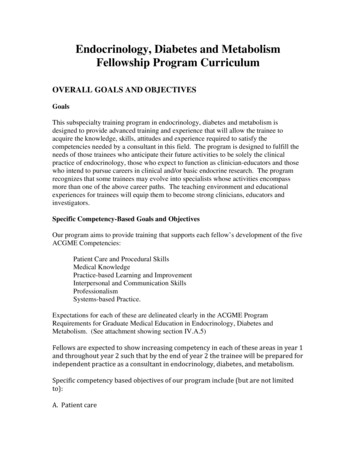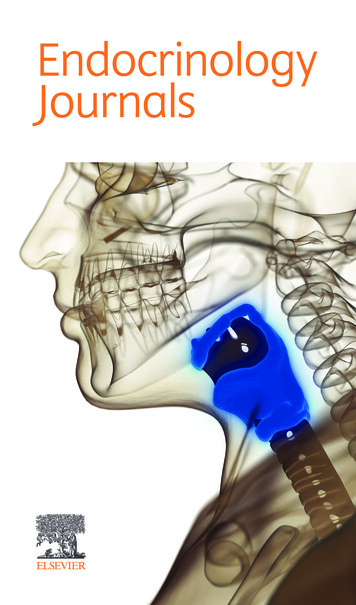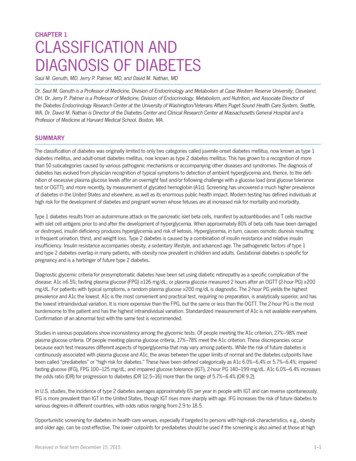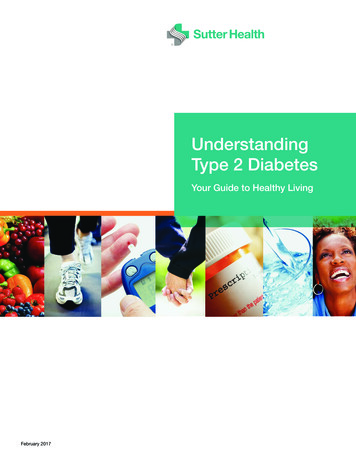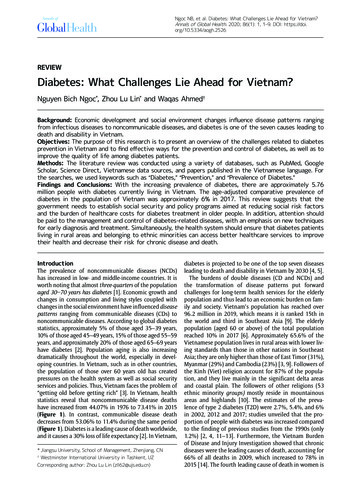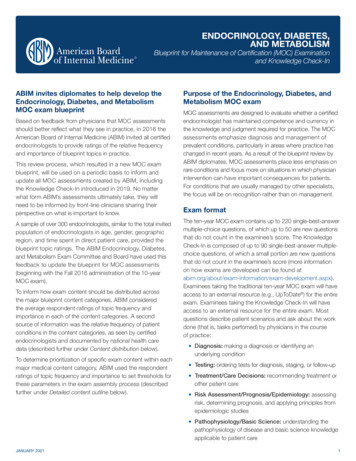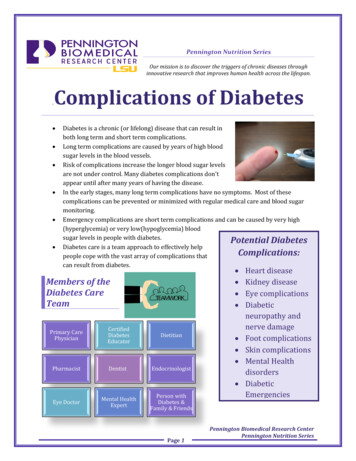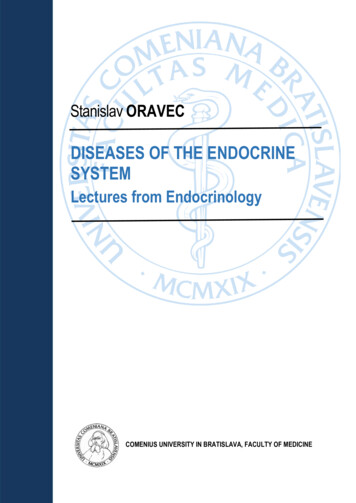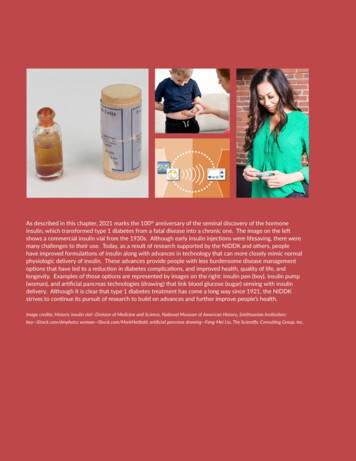
Transcription
As described in this chapter, 2021 marks the 100th anniversary of the seminal discovery of the hormoneinsulin, which transformed type 1 diabetes from a fatal disease into a chronic one. The image on the leftshows a commercial insulin vial from the 1930s. Although early insulin injections were lifesaving, there weremany challenges to their use. Today, as a result of research supported by the NIDDK and others, peoplehave improved formulations of insulin along with advances in technology that can more closely mimic normalphysiologic delivery of insulin. These advances provide people with less burdensome disease managementoptions that have led to a reduction in diabetes complications, and improved health, quality of life, andlongevity. Examples of those options are represented by images on the right: insulin pen (boy), insulin pump(woman), and artificial pancreas technologies (drawing) that link blood glucose (sugar) sensing with insulindelivery. Although it is clear that type 1 diabetes treatment has come a long way since 1921, the NIDDKstrives to continue its pursuit of research to build on advances and further improve people’s health.Image credits: Historic insulin vial—Division of Medicine and Science, National Museum of American History, Smithsonian Institution;boy—iStock.com/dmphoto; woman—iStock.com/MarkHatfield; artificial pancreas drawing—Fang-Mei Liu, The Scientific Consulting Group, Inc.8NIDDK Recent Advances & Emerging Opportunities 2021: Diabetes, Endocrinology, and Metabolic Diseases
Diabetes, Endocrinology,and Metabolic DiseasesNIDDK support of basic and clinical research in the areas of diabetes, endocrinology,and metabolic diseases spans a vast and diverse range of diseases and conditions,including diabetes, osteoporosis, cystic fibrosis, and obesity. Together, these diseases andconditions affect many millions of Americans and can profoundly decrease quality of life.Many of these diseases are complex—an interplay between genetic and environmentalfactors contributes to disease development.Not only is diabetes chronic and relentless, but its slow accumulation of insults to the body can rob a person ofthe ability to see, hear, feel, think, and walk. In addition to increasing the risk for complications of vision loss,kidney failure, and amputation, diabetes doubles risk for heart disease, many forms of cancer, some forms ofdementia, hearing loss, erectile dysfunction, urinary incontinence, and many other common diseases.1 TheNIDDK is vigorously pursuing research to combat diabetes and its associated health consequences.Diabetes is a debilitating disease that affects anestimated 34.2 million people in the United States—or 10.5 percent of the total population—and isthe seventh leading cause of death.2 Althoughoverall rates of diabetes-related complications havedeclined substantially in recent years, disease burdenremains significant as the number of people withdiabetes is still very high.1 Diabetes can affect manyparts of the body and is associated with seriouscomplications, such as heart disease and stroke,blindness, kidney failure, and lower-limb amputation.In addition to these human costs, the estimated totalfinancial cost for diagnosed diabetes in the UnitedStates in 2017—including costs of medical care,disability, and premature death—was 327 billion.3Effective therapy can prevent or delay diabeticcomplications, but nearly one-quarter of U.S. adultswith diabetes are undiagnosed and therefore notreceiving therapy.2Diabetes is characterized by the body’s inability toproduce and/or respond appropriately to insulin, ahormone that is necessary for the body to absorband use glucose (sugar) as a cellular fuel. Thesedefects result in persistent elevation of bloodglucose levels and other metabolic abnormalities,which in turn lead to the development of diseasecomplications. The most common forms of diabetesare type 1 diabetes, in which the body loses itsability to produce insulin, and type 2 diabetes, inwhich the body becomes resistant to insulin, withsubsequent impaired insulin production. In addition,a significant proportion of pregnant women eachyear are diagnosed with gestational diabetes, a formof diabetes that develops during pregnancy, but inmany cases may resolve after pregnancy. However,women who develop gestational diabetes are atgreater risk of developing type 2 diabetes later in life.Untreated, any form of diabetes during pregnancyincreases the risk of serious complications for themother and baby before, during, and after delivery.Type 1 diabetes, formerly known as juvenile diabetes,affects approximately 5 percent of diagnoseddiabetes cases in adults and the majority of diagnosedcases in children and youth.2 It most often develops1Diabetes in America, 3rd ed. Cowie CC, et al., Eds. Bethesda, MD,National Institutes of Health, NIH Pub No. 17-1468, 2018.2Centers for Disease Control and Prevention. National DiabetesStatistics Report, 2020. Atlanta, GA: Centers for Disease Control andPrevention, U.S. Department of Health and Human Services, 2020.3American Diabetes Association. Diabetes Care 41: 917-928, 2018.NIDDK Recent Advances & Emerging Opportunities 2021: Diabetes, Endocrinology, and Metabolic Diseases9
during childhood but may appear at any age.Type 1 diabetes is an autoimmune disease in whichthe immune system launches a misguided attack anddestroys the insulin-producing β (beta) cells of thepancreas. If left untreated, type 1 diabetes resultsin death: without insulin, glucose is not transportedfrom the bloodstream into the body’s cells, where it isneeded, and body metabolism is significantly disrupted,resulting in a severely decompensated and catabolic(a breakdown of molecules such as proteins or lipids)state. This disruption of the body’s metabolism causesa biochemical chain reaction that can result in alife-threatening condition called diabetic ketoacidosis(DKA). DKA can be deadly if it is not aggressivelytreated with insulin. Thus, people with type 1 diabetesrequire lifelong insulin administration—in the form ofmultiple daily injections or via an insulin pump—toregulate their blood glucose levels.The NIDDK’s landmark Diabetes Control andComplications Trial (DCCT)/Epidemiology of DiabetesInterventions and Complications (EDIC) studydemonstrated that keeping blood glucose levels asnear to normal as safely possible reduced the risk ofeye, kidney, nerve, and heart complications associatedwith type 1 diabetes. However, despite vigilance indisease management and current technologies totest blood glucose levels and administer insulin, it isstill not possible for people with type 1 diabetes tomanage blood glucose levels as well as functional,insulin-producing β cells do. Thus, researchers areactively seeking new methods to improve bloodglucose monitoring and insulin delivery. In thisregard, NIDDK-supported research has contributedto the development or testing of new diabetesmanagement technologies recently approved by theU.S. Food and Drug Administration, including the firstcommercial “hybrid artificial pancreas” device thatautomatically links glucose monitoring and insulindelivery, and next-generation continuous glucosemonitors, including the first fully implantable device.Researchers are also working to further develop andenhance β cell replacement therapies, such as islettransplantation, to cure type 1 diabetes.Type 2 diabetes is the most common form of thedisease, accounting for about 90 to 95 percent ofdiagnosed diabetes cases in U.S. adults.2 The risk fordeveloping type 2 diabetes is associated with olderage, obesity, family history of diabetes, history ofgestational diabetes, impaired glucose metabolism,physical inactivity, and race/ethnicity.310Type 2 diabetes occurs at higher rates among racialand ethnic minority populations in the United States,including African Americans, Hispanic and LatinoAmericans, American Indians, some Asian Americans,and Native Hawaiians and Pacific Islanders.2Gestational diabetes is also a risk factor: about half ofwomen with gestational diabetes will developtype 2 diabetes within 5 to 10 years after giving birth.4In people with type 2 diabetes, cells in muscle,fat, and liver tissue do not properly respond toinsulin. As a result, the pancreas initially producesmore insulin to compensate. Gradually, however,the pancreatic β cells lose their ability to secreteenough insulin to restore balance, and the reductionof insulin secretion, relative to the body’s needs,results in elevated and abnormal blood glucose levels.Treatment approaches for managing glucose levelsinclude lifestyle modification (i.e., diet and exercise),and oral and injected medications, with insulin oftenrequired as the disease progresses. There are also anestimated 88 million U.S. adults who have a conditioncalled “prediabetes,” in which blood glucose levels arehigher than normal but not as high as in diabetes.2This population is at elevated risk of developingtype 2 diabetes. Fortunately, the NIDDK-supportedDiabetes Prevention Program (DPP) clinical trial hasshown that people with prediabetes can dramaticallyreduce their risk of developing type 2 diabetes withdiet and exercise changes designed to achieve a7 percent reduction in body weight. To a more limiteddegree, the safe and well-tolerated drug metformincan also help prevent or delay type 2 diabetes.Moreover, follow-up research has shown that thebenefits of reduced diabetes risk from weight loss ormetformin can persist for at least 15 years.Type 2 diabetes was previously called “adultonset” diabetes because it is predominantlydiagnosed in older individuals. However, thisform of diabetes is increasingly being diagnosedin children and adolescents, and in this populationit disproportionately affects youth from racial andethnic minority populations in the United States.Believed to be related to increasing rates of pediatricobesity, this trend is alarming for many reasons.For example, results from the NIDDK-supportedTreatment Options for type 2 Diabetes in Adolescents4Kim C, et al. Diabetes Care 25: 1862-1868, 2002.NIDDK Recent Advances & Emerging Opportunities 2021: Diabetes, Endocrinology, and Metabolic Diseases
and Youth (TODAY) clinical trial and the RestoringInsulin Secretion (RISE) Pediatric Medication Studyshowed that the disease may be more aggressive anddifficult to treat in youth compared to adults. This isworrisome because the onset and severity of diseasecomplications correlate with diabetes duration andmanagement of blood glucose levels, so those withearly disease onset are at especially high risk fordeveloping complications. In addition, increasingrates of type 2 diabetes in girls may lead to morewomen who enter pregnancy with diabetes, andmaternal diabetes during pregnancy—either onset oftype 2 diabetes before pregnancy or the developmentof gestational diabetes during pregnancy—confers anincreased risk of type 2 diabetes in offspring. Thus,the rising rates of diabetes and prediabetes in youngwomen could contribute to a cycle of ever-growingrates of diabetes. Therefore, the advent oftype 2 diabetes in youth has the potential to worsenthe enormous health burden that diabetes alreadyplaces on the United States.The NIDDK is supporting research to betterunderstand metabolism and the mechanismsthat lead to the development and progressionof diabetes and the many other endocrine andmetabolic diseases within the NIDDK’s mission;such research will ultimately spur the design ofpotential new intervention strategies. In parallel,based on knowledge from past scientific researchinvestments, the NIDDK is vigorously pursuingstudies of prevention and treatment approaches forthese diseases.data on the scope of and trends in the disease.This research continues to highlight important andconcerning information.In this report, SEARCH researchers compared therates of development (incidence) of type 1 andtype 2 diabetes from 2002 to 2015 to determinewhether the annual rates were changing. For type 1diabetes, the scientists determined an overall rateof increase of 1.9 percent per year. They observedthe steepest increases among racial/ethnic minoritypopulations: Asian and Pacific Islanders (4.4 percentper year), Hispanics (4.0 percent per year), and Blacks(2.7 percent per year). In contrast, incidence amongWhites rose 0.7 percent per year, and an increasewas not observed among American Indians.Among youth with type 2 diabetes, the annual rateof increase in incidence was determined to be 4.8percent per year. Again, the researchers observedthe highest increases among racial/ethnic minoritypopulations: Asian and Pacific Islanders (7.7 percent),Hispanics (6.5 percent), Blacks (6.0 percent), andAmerican Indians (3.7 percent). These trends areworrisome as research supported by the NIDDKhas demonstrated that type 2 diabetes is moredifficult to treat in youth than adults as youth maynot respond as well to medications used in adults,and that many youth with type 2 diabetes developcomplications early in their lives. These datahighlight the continued need for research to preventand treat both type 1 and type 2 diabetes.Divers J, Mayer-Davis EJ, Lawrence JM, Wagenknecht LE. TrendsASSESSING DIABETES RATES IN YOUTHDiabetes Continues To Rise Among American Youth:Scientists demonstrated that rates of both type 1and type 2 diabetes continue to increase in peopleunder the age of 20 in the United States, with higherrates of increase among racial/ethnic minorityyouth. Diabetes is a common chronic disease andresults in increased risk for serious complications ofthe heart, kidneys, and eyes, among others. Effortsto understand the burden of this disease amongdifferent populations are essential to developmentof targeted public health efforts to help people atrisk for or diagnosed with diabetes. The SEARCHfor Diabetes in Youth study, a joint effort supportedby the NIDDK and the Centers for Disease Controland Prevention, was established in 2000 to producein incidence of type 1 and type 2 diabetes among youths—selectedcounties and Indian reservations, United States, 2002-2015. MMWRMorb Mortal Wkly Rep 69: 161-165, 2020.RESEARCH ON TYPE 1 DIABETESNew Artificial Pancreas System OutperformsSensor-augmented Pump Therapy for ManagingType 1 Diabetes: A clinical trial has found that anew artificial pancreas system is more effectivethan sensor-augmented pump (SAP) therapy atincreasing the time people with type 1 diabetesspend with blood glucose (sugar) levels in a healthyrange, knowledge that led to U.S. Food and DrugAdministration (FDA) approval of the new systemin 2019. Artificial pancreas technology, or a closedloop system, aims to automate type 1 diabetesNIDDK Recent Advances & Emerging Opportunities 2021: Diabetes, Endocrinology, and Metabolic Diseases11
management by measuring blood glucose levelsusing a continuous glucose monitor (CGM) andautomatically delivering insulin when needed usingan insulin pump. By contrast, SAP therapy—thecontrol treatment used in the trial—couples CGMuse with an insulin pump but does not adjust insulinlevels automatically. Thus, by automating diabetesmanagement, artificial pancreas technology holdspromise to help people with type 1 diabetes achieverecommended blood glucose levels day and night, aswell as alleviate the enormous burden associated withmanaging the disease. A first-generation closedloop system was approved by the FDA in 2016, andresearchers have continued working to develop newand improved systems.Researchers in the NIDDK-supported, multi-centerInternational Diabetes Closed-Loop (iDCL) Studyenrolled 168 female and male participants ages14 to 71 years with type 1 diabetes. Participantswere randomly assigned to use either SAP therapyor an artificial pancreas system called Control-IQTM.Some unique features of the artificial pancreassystem include a dedicated safety module toprevent hypoglycemia (dangerously low bloodglucose levels), and gradually intensified bloodglucose control overnight to target near-normalblood glucose levels every morning. During the6-month trial, participants lived their normal dayto-day lives and only had contact with study staffevery 2 to 4 weeks to download and review devicedata. Results showed that artificial pancreas userssignificantly increased the amount of time withtheir blood glucose levels in the recommendedtarget range (percent increase in time in range) byan average of 2.6 hours per day, while the time inrange in the control SAP group remained unchanged.Compared to the SAP group, artificial pancreas usersalso showed improvements in their average bloodglucose control (HbA1c levels) and had less high andlow blood glucose. There were no severe episodesof hypoglycemia in either group.These positive trial data—showing that theartificial pancreas system outperformed SAPtherapy—were used by the FDA to approvemarketing of the Control-IQ technology. TheControl-IQ technology itself was derived from asystem originally developed with NIDDK support.This success story demonstrates how the sustainedand long-term NIDDK investment in research—from technology development to supporting12clinical trials testing the technology and the clinicaltrial demonstrating the efficacy of the system—culminated in a new commercially available device toimprove type 1 diabetes management.Brown SA, Kovatchev BP, Raghinaru D, Beck RW; iDCL Trial ResearchGroup. Six-month randomized, multicenter trial of closed-loop controlin type 1 diabetes. N Engl J Med 381: 1707-1717, 2019.Researchers Develop First Functional, Lab-generatedIslets That Evade Immune System Attack: Scientistshave developed functional human islet-likeorganoids (HILOs) that can be shielded from immunesystem attack, an advance that allowed these HILOsto treat a mouse model of type 1 diabetes for weekswithout immunosuppressive drugs. Pancreatic isletdysfunction can compromise the body’s ability tomaintain healthy blood glucose (sugar) levels. Intype 1 diabetes, the immune system plays a key rolein this dysfunction, destroying insulin-producingβ (beta) cells in the islets. Transplanting healthy,insulin-producing islets into people with diabetescan help manage blood glucose levels without theneed for insulin injections, but several major issueskeep this procedure from being routinely used. Onehurdle is that limited amounts of cadaveric isletsof transplantable quality are available. Anotherissue is that immunosuppressant drugs that cancause serious side effects must be used to preventtransplant rejection. However, making human isletlike cell clusters in the lab that both mimic healthyislets and evade the immune system has proven tobe challenging.Now, a group of scientists has identified physicaland biological factors needed to produce functional,immune-evading HILOs. Building on previousresearch, they grew β-like cells derived from humaninduced pluripotent stem cells in a gel-like,three-dimensional scaffold that more closely mimicsthe human pancreas. These growing conditionsproduced mature cell clusters that had many of thecharacteristics of healthy islets, including producinginsulin in response to glucose and reducing bloodglucose levels in a mouse model of type 1 diabetes.But how could these HILOs be protected fromimmune attack? Previous work had suggested thata protein called PD-L1 helps shield islets from theimmune system. When the scientists treated HILOsto induce PD-L1 production, these HILOs wereprotected from immune attack when transplantedinto a mouse model of type 1 diabetes. Even whenNIDDK Recent Advances & Emerging Opportunities 2021: Diabetes, Endocrinology, and Metabolic Diseases
transplanted into a mouse model engineered to havea human-like immune system, the HILOs providedsteady blood glucose control for over 50 dayswithout the need for immunosuppression.More research is needed to clarify how long the HILOs’immune protection can last and how long they canremain functional when transplanted. These issuesand others are key to determining whether HILOscan be used to manage blood glucose levels in peoplewith diabetes. Overall, these findings give hope thatit may one day be possible to protect transplantedislets in the human body from immune attack. Suchadvances could lead to improved treatments thatfree people with type 1 diabetes from the needfor insulin injections without incurring the risks ofimmunosuppression.Yoshihara E, O’Connor C, Gasser E, Evans RM. Immune-evasivehuman islet-like organoids ameliorate diabetes. Nature 586: 606611, 2020.Insights into the Autoimmune Process in Type 1Diabetes: Using a systematic approach, researchersidentified and characterized the protein fragments(peptides) associated with β (beta) cell autoimmunity,a misguided immune attack on the β cells of thepancreas that leads to type 1 diabetes. Normally,the immune system defends the body against foreigninvaders or pathogens. Immune molecules known asmajor histocompatibility complex (MHC) moleculesbind peptides from the pathogens and display themfor recognition by immune cells called T cells. Thisprompts the T cells to “activate,” leading them to attackthe pathogen. In many people with type 1 diabetes,however, variants of class II MHC molecules (MHC-II)inappropriately bind and display peptides from theinsulin-producing β cells. When this happens, the Tcells can be activated by these peptides, leading themto target the β cells. While decades of research haveadded knowledge about this process, much remainsunknown, including identification of all the peptidesthat drive the autoimmune process in type 1 diabetes.Understanding the molecular components involvedin triggering the attack and its progression could leadto earlier and improved detection of the disease, abetter understanding of disease progression, and newprevention and treatment approaches.To understand further what triggers the autoimmuneattack, researchers sought to catalog the“immunopeptidome” of β cell-derived peptidesdisplayed by MHC-II in a mouse model of type 1diabetes. By examining the β cells, pancreatic lymphnodes, and spleens of female mice, they found that themost prominent peptide families bound to MHC-II inthose sites were those derived from insulin B-chain(InsB) and C-peptide (InsC). To determine whetherthese peptides induced an autoimmune response, theresearchers characterized the peptides both on theirability to induce a reaction from a specific type of T celland on how well they bound MHC-II. They confirmedthat most of the T cell reactivity was directed to InsBand InsC. Further experiments allowed the researchersto determine additional features of these peptidesthat affect reactivity and enhance binding to MHCII, such as chemical modifications and segmentsthat were particularly immunogenic. These findingsidentified what parts of the insulin protein trigger theautoimmune attack on β cells in this mouse modelof type 1 diabetes. Additional research will benecessary to determine whether these findings extendto humans.Wan X, Vomund AN, Peterson OJ, Chervonsky AV, Lichti CF, andUnanue ER. The MHC-II peptidome of pancreatic islets identifies keyfeatures of autoimmune peptides. Nat Immunol 21: 455-463, 2020.Identification of Risk Factors for Heart Diseasein Type 1 Diabetes: Researchers determined thatblood glucose (sugar) levels and age are the strongestrisk factors for total cardiovascular disease (heartdisease and stroke) burden in people with type 1diabetes. Cardiovascular disease remains a leadingcause of death for people with type 1 diabetes,despite improvements in the control of blood glucose,blood pressure, and lipid (fat) levels. Insights intotype 1 diabetes and cardiovascular health previouslycame from the NIDDK’s landmark Diabetes Controland Complications Trial (DCCT) and its followup, the Epidemiology of Diabetes Interventionsand Complications (EDIC) study. DCCT/EDICdemonstrated that higher levels of hemoglobinA1c (HbA1c; a measure of average blood glucoselevels over 3 months) were a strong risk factor forcardiovascular disease. These findings, however, werelimited to analyzing the risk of a first cardiovascularevent. Because subsequent cardiovascular events areassociated with significant morbidity and mortality,understanding their risk factors could improveprevention strategies.To extend their previous analyses, the researchersevaluated potential risk factors for their associationNIDDK Recent Advances & Emerging Opportunities 2021: Diabetes, Endocrinology, and Metabolic Diseases13
with first and subsequent cardiovascular events after29 years of follow-up of DCCT/EDIC participants.They found that older age was associated with anincreased risk of cardiovascular death and with otherfirst and subsequent events including heart attack,stroke, and congestive heart failure. Additionally, theyfound that higher levels of HbA1c were associatedwith increased risk of both the first and subsequentevents. These findings confirm the importance ofintensive glucose control to reduce the risk of a firstcardiovascular event. They also suggest that after thefirst event, it is still important for people with type 1diabetes to practice intensive blood glucose control toreduce their risk of a subsequent event. Importantly,blood glucose levels can be managed for many peoplewith technologies like continuous glucose monitorsand improved insulin delivery devices, making intensiveblood glucose control more achievable. Continuedresearch is needed to understand how blood glucoselevels affect cardiovascular disease toward improveddetection, prevention, and treatment in people withtype 1 diabetes.With these new findings, it is clear that the long-termdedication of the DCCT/EDIC volunteers and theinvestigators continues to generate a treasure trove ofdata about type 1 diabetes and its complications that isidentifying ways to improve the health of people withthis disease.Bebu I, Schade D, Braffett B, Lachin JM; DCCT/EDIC Research Group.Risk factors for first and subsequent CVD events in type 1 diabetes:The DCCT/EDIC Study. Diabetes Care 43: 867-874, 2020.RESEARCH ON TYPE 2 DIABETESCommunity-based Approach To ScreenBlack Men for Type 2 Diabetes: Researchers havefound that community barbershops are promisingvenues for screening Black men for type 2 diabetesand identifying those with undiagnosed disease,so treatment could begin earlier. Many peoplewith type 2 diabetes do not know they have it,and minority groups have disproportionately highrates of undiagnosed diabetes. Timely diagnosis isimportant so that people with the disease receiveappropriate treatment to control their bloodglucose (sugar) levels and prevent life-threateningcomplications. Black men with diabetes have highrates of diabetes complications and are less likelyto live into their seventies than men from other14racial/ethnic groups. However, type 2 diabetesdiagnosis is often delayed, particularly in Black menwho do not receive regular primary care and thusmay not ever be screened or tested for the disease.Thus, it is important to identify approachesfor timely diagnosis of type 2 diabetes in thispopulation to improve their health.In a recent study, researchers examined whethera community-based approach using barbershopsowned by Black individuals could identify Blackmen with undiagnosed type 2 diabetes. Theresearchers asked 895 Black men at 8 differentbarbershops in Brooklyn, New York, if they wouldbe willing to be screened for type 2 diabetes usinga type of hemoglobin A1c (HbA1c) test that canbe administered onsite and that gives results in 5minutes. About one-third of the men agreed tobe screened and 290 were successfully tested.Testing showed that 26 men (9 percent) hadundiagnosed type 2 diabetes and 82 (28 percent)had prediabetes—a condition of intermediate bloodglucose levels that is a known risk factor for laterdeveloping type 2 diabetes. The researchers gavethe men with diabetes or prediabetes follow-upinformation, including the names of local primarycare clinics. The most common reason participantsgave for declining screening was because theyalready knew their health status or were under adoctor’s care. Some limitations of the study includethe fact that it took place in only one city, so it isunknown if similar participation rates would beobserved in other areas of the country. In addition,although the point-of-care HbA1c test used is veryconvenient and fairly accurate, follow-up laboratorytests, which were not included in the study, wouldbe needed to confirm the initial diagnoses.Community-based approaches at barbershops havebeen used successfully for addressing other healthconditions, such as identifying and treating Blackmen with high blood pressure. Therefore, adoptingstrategies like the one in this study to help identifypeople with undiagnosed type 2 diabetes who wouldbenefit from treatment—particularly if paired withapproaches for lowering other barriers to obtainingproven therapies—hold promise to yield progresstoward U.S. health equity.Osorio M, Ravenell JE, Sevick MA, Lee DC. Community-basedhemoglobin A1c testing in barbershops to identify Black men withundiagnosed diabetes. JAMA Intern Med 180: 596-597, 2020.NIDDK Recent Advances & Emerging Opportunities 2021: Diabetes, Endocrinology, and Metabolic Diseases
Rare Genetic Variants Protect Against Type 2Diabetes by Promoting Insulin Processing andSecretion: Studying rare variations in the geneSLC30A8 that were previously found to protectagainst type 2 diabetes, researchers have nowdiscovered that these variations promote releaseof insulin in response to a rise of blood glucose(sugar) levels, potentially by increasing theproportion of insulin that is ready for releaserelative to a precursor form of the hormone. Aprevious genetic study of thousands of peoplefrom several parts of the world showed that veryrare variants of SLC30A8—found in about 1 in5,000 people—significantly reduce the risk oftype 2 diabetes. The gene encodes a proteincalled ZnT8 that helps package insulin in a formthat is compact yet can be quickly rele
8 NIDDK Recent Advances & Emerging Opportuniies 2021: Diabetes, Endocrinology, and Metabolic Diseases As described in this chapter, 2021 marks the 100th anniversary of the seminal discovery of the hormone insulin, which transformed type 1 diabetes from
